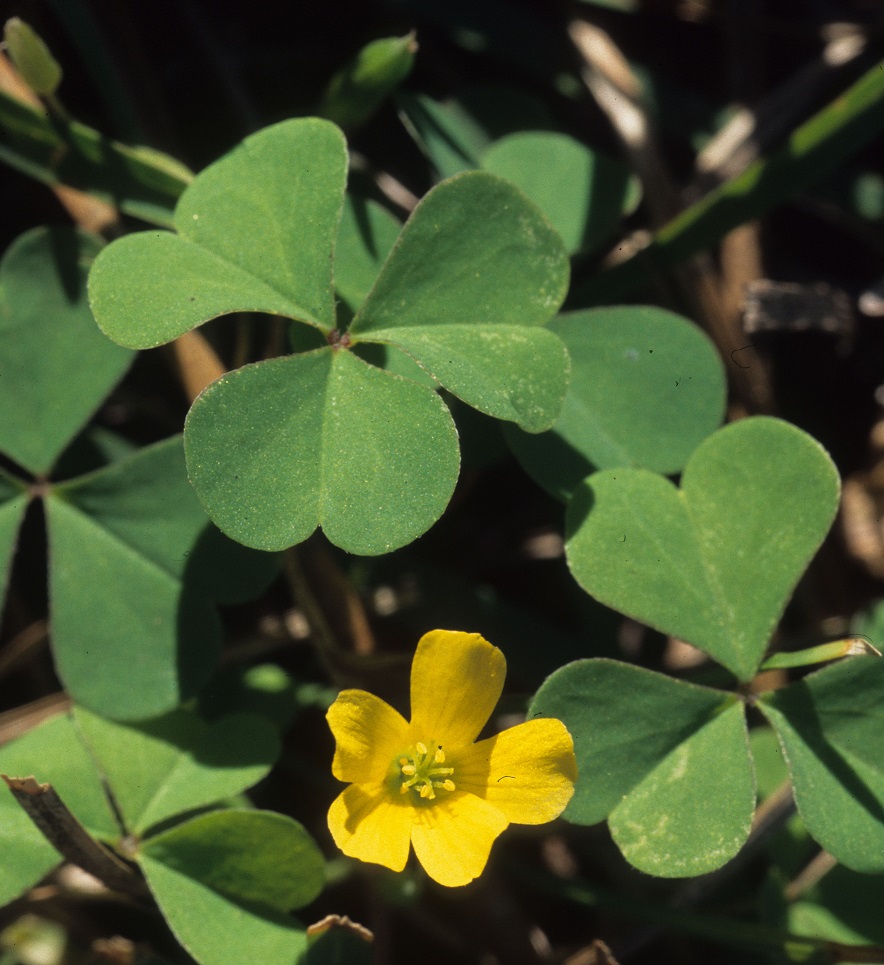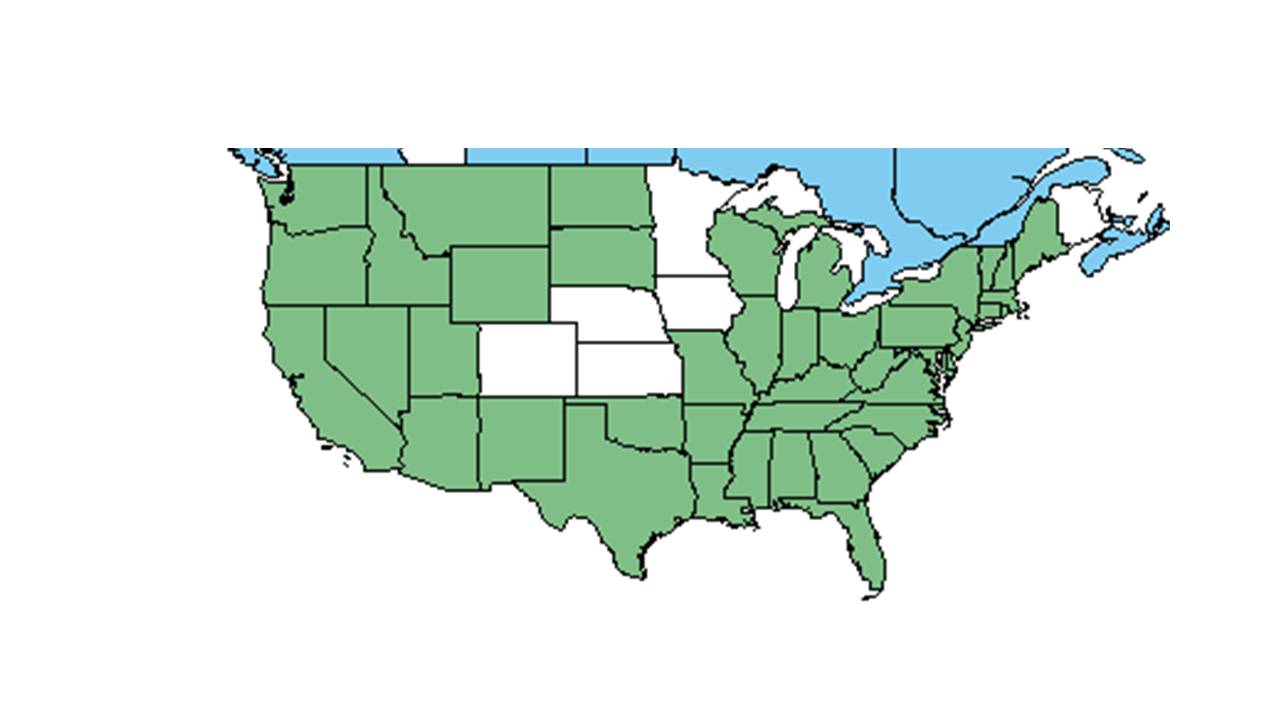Oxalis corniculata
| Oxalis corniculata | |
|---|---|

| |
| Photo taken by Gil Nelson | |
| Scientific classification | |
| Kingdom: | Plantae |
| Division: | Magnoliophyta - Flowering plants |
| Class: | Magnoliopsida – Dicotyledons |
| Order: | Geraniales |
| Family: | Oxalidaceae |
| Genus: | Oxalis |
| Species: | O. corniculata |
| Binomial name | |
| Oxalis corniculata L. | |

| |
| Natural range of Oxalis corniculata from USDA NRCS Plants Database. | |
Common names: creeping woodsorrel; creeping lady's-sorrel[1]
Contents
Taxonomic notes
Synonyms: Oxalis repens Thunberg[1]
Varieties: Xanthoxalis corniculata (Linnaeus) Small; Xanthoxalis langloisii Small; O. corniculata var. corniculata; O. corniculata var. atropurpurea Planchon[1]
Description
"Caulescent or acaulescent, herbaceous perennials with rhizomes or bulbs, or annuls with fibrous roots. Leaves alternate, ternately compound, leaflets 3, obcordate; stipules very small or obsolete. Flowers in pedunculate umbels or cymes, or solitary. Sepals 5; petals 5 separate or adnate to each other just above the base; stamens 1-, of 2 lengths. Pistil with 5 carpels. Capsule longitudinally dehiscent. Seeds red, prominently reticulate, pitted or smooth, each completely enclosed by an elastically dehiscent, transparent aril that aids in its distribution. Heterostyly is typical of plants in this genus. " [2]
"Caulescent, stoloniferous herb with fibrous roots. Stolons completely prostrate, usually bearing roots at each node, and usually flowering from the axils of leaves from rooted nodes. Stems, petioles, and peduncles, slightly pilose. Leaflets green, reddish or purplish, ca. 2 cm long or often considerable less. Peduncles mostly shorter than the subtending petioles, mostly 1-or 2-flowered. Sepals not gland-tipped; petals yellow, 5-7 mm long. Capsule prismatic, 0.8-1 cm long, sparsely pubescent. Seeds reticulate." [2]
Distribution
O. corniculata is native of New World tropics and subtropics, but is now nearly worldwide in distribution.[1]
Ecology
Habitat
O. corniculata occurs in moist to dry sandy or loamy soils. [3] It can be found in lowland woodlands, as well as disturbed sites, including along trails, mowed lawns, and near man-made ponds. [3]
Phenology
O. corniculata flowers from February through December.[1]
Seed bank and germination
Commonly found in seed banks of disturbed areas. [4] Forms a persistent soil seed bank. [5] Found in the seed bank of an ectone region of longleaf pine and scrub communities in the western panhandle of Florida. [6]
An early 2000s study found that O. corniculata is found in the seed banks of pine flatwoods and old agricultural field soils.[7]
Fire ecology
Populations of Oxalis corniculata have been known to persist through repeated annual burning.[8]
Conservation, cultivation, and restoration
Cultural use
Wood sorrel is edible in small quantities on salads. The plant can act a sort of tonic and is supposedly refreshing to eat.[9]
Photo Gallery
References and notes
- ↑ 1.0 1.1 1.2 1.3 1.4 Weakley, A.S. 2020. Flora of the Southeastern United States. Edition of 20 October 2020. University of North Carolina at Chapel Hill, Chapel Hill, North Carolina.
- ↑ 2.0 2.1 Radford, Albert E., Harry E. Ahles, and C. Ritchie Bell. Manual of the Vascular Flora of the Carolinas. 1964, 1968. The University of North Carolina Press. 646-8. Print.
- ↑ 3.0 3.1 Florida State University Robert K. Godfrey Herbarium database. URL: http://herbarium.bio.fsu.edu. Last accessed: June 2014. Collectors: Loran C. Anderson, Bian Tan, J. M. Kane, Robert K. Godfrey, and Andre F. Clewell. States and Counties: Florida: Alachua, Franklin, Leon, and Washington. Georgia: Grady and Thomas.
- ↑ Maliakal, S. K., E. S. Menges, et al. (2000). "Community composition and regeneration of Lake Wales Ridge wiregrass flatwoods in relation to time-since-rire " The Journal of the Torrey Botanical Society 127: 125-138
- ↑ Navarra, J. J., N. Kohfeldt, et al. (2011). "Seed bank changes with time since fire in Florida rosemary scrub." Fire Ecology 7(2).
- ↑ Ruth, A. D., et al. 2008. Seed bank dynamics of sand pine scrub and longleaf pine flatwoods of the Gulf Coastal Plain (Florida). Ecological Restoration 26:19-21.
- ↑ Jenkins, Amy Miller. Seed banking and vesicular-arbuscular mycorrhizae in pasture restoration in central Florida. University of Florida. 2003.
- ↑ Platt, W.J., R. Carter, G. Nelson, W. Baker, S. Hermann, J. Kane, L. Anderson, M. Smith, K. Robertson. 2021. Unpublished species list of Wade Tract old-growth longleaf pine savanna, Thomasville, Georgia.
- ↑ Fernald, et al. 1958. Edible Plants of Eastern North America. Harper and Row Publishers, New York.